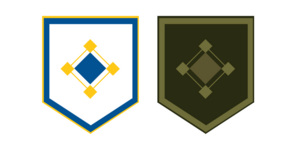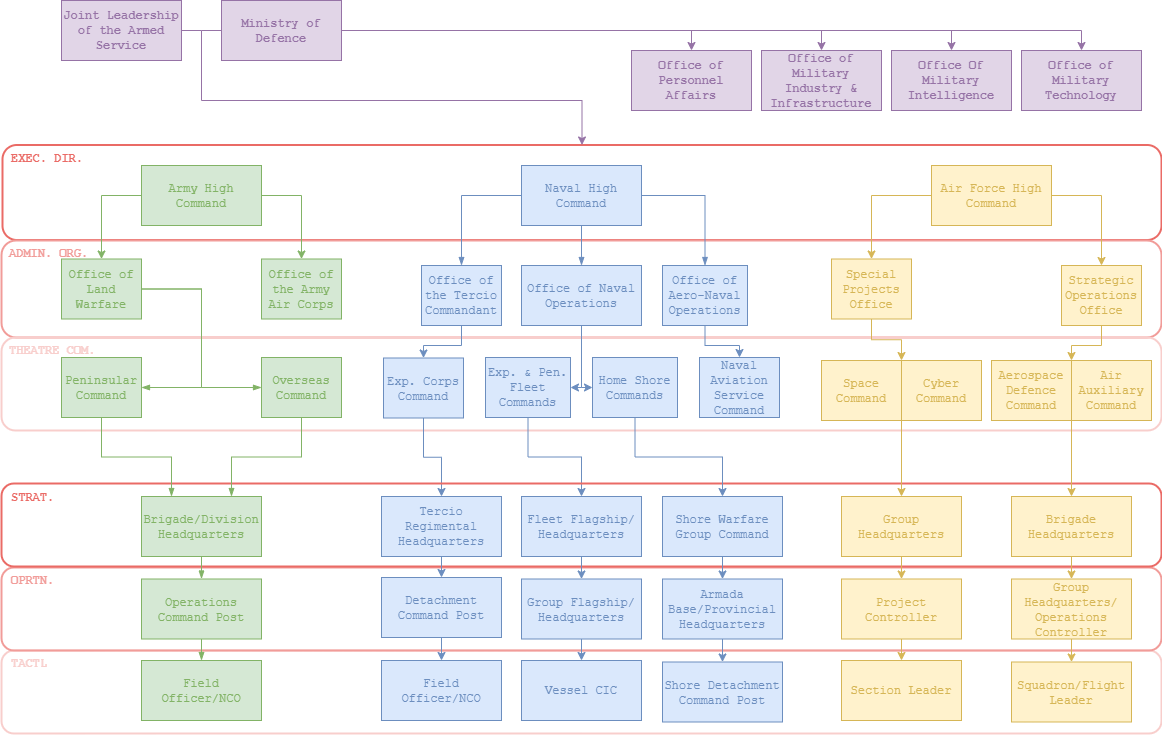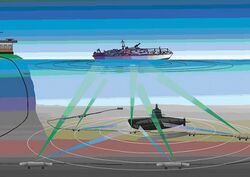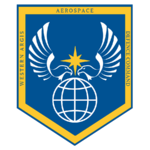Republican Armed Service
| Military of The Republic of Iverica | |
|---|---|
| Armaté Servicio dei L'República Iverica | |
 | |
| Motto | Gloria Fortis Miles (Aroman)
"Glory to the Brave Soldier" |
| Founded | Guardia Expediciónare: 1620 Guardia Peninsulares: 1650 |
| Current form | Armaté Servicio dei L'República Iverica: 1820 |
| Service branches | |
| Headquarters | Corregidor Superioré Comando (Corregidor High Command) |
| Leadership | |
| Commander-in-Chief (Executive) | Franso Deitorr |
| Minister of Defence | Ricardo Ibanes |
| Commander-in-Chief (Military) | CCO. Ferran-Arnau Macharius |
| Personnel | |
| Conscription | No |
| Available for military service | 8,007,694 males, age 17-49 (2019 est.), 7,962,099 females, age 17-49 (2019 est.) |
| Fit for military service | 7,775,889 males, age 17-49 (2019 est.), 6,342,945 females, age 17-49 (2019 est.) |
| Reaching military age annually | 323,699 males (2019 est.), 320,829 females (2019 est.) |
| Active personnel | 540,000 |
| Expenditure | |
| Budget | $126.990 billion (FY17) |
| Percent of GDP | RAS-2020: 6% Nominal: 4% |
The Republican Armed Service (Iverican: Armaté Servicio dei L'República Iverica) is the official militarised force of the Republic of Iverica. The RAS is tasked with the defence of the state and its citizens. Should it be necessary, the Service will be tasked with the prosecution of war against another state. It consists of the Exersito, Armada, Fuersas L'Aire and the Guardia Civil. For special warfare, the RAS maintains a semi-autonomous Special Operations Command for units like SOAR.
The Service employs only volunteering citizens. The RAS has a total of 540,000 enlisted men and women with a darft potential estimated to be in excess of 9 million. The Primo of Iverica serves as the Commander-in-Chief, though command of the Armed Service is mainly relegated to the Júnt-Capos D'Armaté Servicio (JCAS), led during wartime by the Capo-General D'Armaté Servicio, and in peacetime by the Ministero dei Defensa.
History
The history of Iverican military forces in the continent of Argis begins in recorded sources on September of 1620, with the creation of the Guardia Expendiciónare, predating the Narvic Blood Compact. The subsequent Consitution of the First Republic marked the establishment of the Republic of Iverica and the renaming of the provisionary forces to the Guardia Peninsulares. The Armada Iverica and the Tercios dei L'República, both established on the same date, were created as successors to the provisionary Armada and infantry forces by the Iveric exodites during the Gran Viatge in order to defend the new nation against marauding Alharun and Argic kingdoms.
During the reformation in 1765, shortly after the "Decades of Civil Strife", the Peninsular Guard was replaced with the "Exersito Iverica" and the joint entity know as the Republican Armed Service was formed thereafter. The term and now outdated reference of the "Peninsular Guard" now only applies to the Guardia Civil standing forces activated in case of invasion or internal crises.
In 1920, the Fuersas L'Aire was formed in order to respond to neighbouring countries' growing dependence on aircraft for both civil and military use.
In 1964, Iverica entered into an allaince with Prymont and established the Western Argis Aerospace Defence Command
In 2018, the Gallambrian "Joint Over-The-Horizon Radar Network" (JOTHRN) technologies were used to upgrade WARD OTH capabilities. With the establishment of Tricontinental Defence Treaty Organisation, WARD and JOTHRN cooperate to provide an air defence umbrella that covers much of the Argic Ice Caps, Argis, The North Oriental Ocean, Northern and Central Alharu, Western Aurelia, Thalassa, Marenesia, and the Mid-Adlantic Ocean.
Organization
Command of the Armed Service rests with the Republic's Primo under counsel from the Júnt-Capos. The Júnt-Capos typically assemble at the military headquarters of Corregidor High Command, Nou Tacalonia, though auxiliary commands are scattered around the peninsula in case of a directed strike at the military's command structure.
The Armed Service is subdivided into 4 major service branches: Exersito, Armada, Fuersas L'Aire, and Guardia Civil. Each branch maintains a separate headquarters, command structure and training programme. Each branch is also required to maintain a Regimental Command base in every state as well as (at least) one Joint-Forces Station (JFS) with each other branch allowing for greater cooperation capability with other branches.
From the High Command, orders are passed to the Regimental Commands in each state or region or to Theatre Commands in foreign deployments. For the Armada, orders from Corregidor are passed to either the fleet flagship or the flotilla flagship.
Júnt-Capos D'Armaté Servicio
Known as "Joint Chiefs of the Armed Service", in common language, this body is composed of 8 members from all branches of service, the Executive Ministry, and the Legislature. Collectively the body represents the Republic of Iverica's command of all military forces during wartime. It is composed of the Capo-General, Capo dei Exersito, Capo-Almirante D'Armada, Capitan-Commandante dei Fuersas-Marinas, Capo dei Fuersas L'Aires, Capo dei Guardia Civil, Minister of Defence, and the Cámra Consul. During a wartime setting, the JCAS meets via secure telecommunication channels to coordinate a Combined-Arms effort to achieve the resolution to any conflict the Republic of Iverica may be faced with. It implements its own policies and procedures to see to a quick and efficient decision-making process.
Structure
The Commander-in-Chief (Capo-Comandante) of the Armed Service is the Primo of Iverica, currently Primo Franso E. Deitorr.
The Minister of Defence (as peacetime chairperson) and Capo-General (wartime counterpart) oversee operations of RAS. They also oversee such bodies as the Lideratge, Comando, and the Military subsidised industries. However, military policy is ultimately directed by the Executive Ministry.
- Ministerio dei Defensa: is the lead organisation, highest command and management of the Republican Armed Service.
- Júnt-Capos D'Armaté Servicio: is the leading agency all levels of the RAS, command all of the armed forces, which functions to ensure combat readiness of the armed forces and manage all military activities in peace and war.
Outside Regular Structure:
- Oficina D'Asuntos Personal: an agency managing personnel affairs such as welfare, pension, recruitment, and other human resources.
- Oficina D'Industria et Infraestructura Militar: is the agency in charge of managing military industry, both public and private. Also tasked with maintaining and improving military infrastructure like base assets, transportation arrangements/avenues, and auxiliary facilities.
- Oficina D'Intelligensia Militar: is an intelligence agency of the RAS and its subordinate offices.
- Oficina dei Technicia Militar: is the agency in charge to ensure equipped technical means of war for each unit.
General Doctrine
The Republican Armed Service's (RAS) primary goals are national defence and enforcement of Iverican policy abroad. Its specific concerns centre around the following theatres: missile threats from unstable nations in Europa, Argis, and Aurelia; the proliferation of insurgent activities in Argis and Alharu; the safeguarding of overseas Iverican holdings from any malicious actors; and the policing and regular force-projection in adjacent waters like the Mediargic Seas, the Northern Argic Passages, and the North Oriental Ocean.
Geographically, Iverica's position as adjacent to the Mediargic Seas, Oriental Ocean, and Argic Ocean requires the nation to defend its peninsular and archipelagic territories with a strong naval presence. Its strategic position at the centre of heavy maritime traffic means that it must project its military strength over shipping routes that feed and profit the nation's main industry of components manufacturing. Additionally, the RAS build-up of naval power is effective for executing and upholding Iverican foreign policy which has grown more involved with external affairs over the past decade.
Materially, the RAS is seeks to maintaince the above specialisation by its exploitation of domestic and foreign resources. The RAS is capable of sustaining its requisites of base metals, alloys, conductors, semi-conductors and propellant through nationalised public industries and private enterprise. Its native industry-leading market of private and national arms manufacturers make up the bulk of the RAS' suppliers. However, resource gaps and technological challenges exist that the RAS and the other organs of the Government of Iverica aim to fill with foreign supply and service respectively. One of the RAS' economic challenges is the scarcity of oil and other combustible fuels within Iverica's sovereignty. Recent partnerships with other Argic nations such as the United States of Prymont have yielded a steady supply, despite adding further importance and burden to RAS' maritime policing roles. Another challenge consists of the technological gaps left by defence industries previously relied upon by the RAS. Specifically, the temporary loss of Suisa Defence Aeronautics, the leader in Iverican aircraft and avionics technology, to the recessions in the 20th century. Addressing the issue, the RAS has relied heavily on its allies in both directly supplying airframes and other aerial warfare technology; and in providing consulting insight for restarting domestic research and development.
To fulfill its goals and specific concerns, the RAS aims to maintain a defensive ground force in concert with a power-projecting naval and aero-naval force. It prioritises the maintenance and efficiency of a relatively low-manpower but high-technology ground army and air force for defence while continually expanding a large blue-water navy supported by a capable naval aviation corp. The entire armed service's composition and expenditure allocation places great emphasis on naval power and naval air power, with the Navy being the largest and lead branch with responsibilities ranging from the defence of adjacent waters to foreign aid and intervention. The branches of the Exersito (Army) and Fuersas L'Aire (Air Force) primarily serve logistical, fire support, and defensive roles, as their doctrines are built on the support of the Navy and defence of the homeland as top priorities.
Planning, training, and operating to meet the mentioned specialised standards and effectively, to fulfill the doctrinal goals, the RAS's general doctrine as of 2020 is loosely summarised in the following points.
Priorities in planning range from the following: missile contingency preparation; organising adaptive patrol operations in adjacent waters; strategising small-scale embargos on rogue states, actors threatening Iverican nationals, or risks to Iverican commerce; and quick, but strategically effective operations-level reprisals or interventions to protect diplomatic or economic interests. Planning also prioritises defensive contingency operations like counter-invasion ground and air operations though due to Iverica's geographic position, preparation for this type of priority remains mostly in simulation and occasionally in drills.
Training necessary skillsets in Iverica's quickly growing, largely young population varies per branch. Despite this, some concepts are common to all branches. One is the recruiting principle of maintaining professional army of volunteer soldiers, all of which should be able to render basic combat service in accordnance with the training provided. Another, is a somewhat regimental system of keeping recruitment and direct administration of personnel within the purview of regimental officers. Tactics and strategies taught and utilised by the RAS typically emphasise an organised use of speed and initiative to seize strategic areas quickly and make best use of their force multipliers to avoid a protracted conflict. This is possible because of a constant effort to maintain a high-percentage of mechanised, air assault, or air mobile units among combat units. In turn, this level of training, equipment and supply is only possible because of the RAS' organisation as a volunteer force of specialised, career personnel mostly effective inside operation-scale theatres. RAS' planning priorities, operational norms, and training foci allow for commanders to creatively affect regulations to provide greater combat flexibility and more localised control of operations. Furthermore, a high-degree if freedom is granted to officers from company-level upwards. Commanders are often able to positively affect the speed and coordination of their subordinate elements by applying measures such as vehicle jury-rigging, altered SOPs on resource use and REDCON procedure, and altered composition of non-essential field kit. This level of operational freedom, when maintained with effective and disciplined communication, allows RAS units to seize objectives quickly, to execute a speedy and effective disruption of enemy networks, and to preemptively exploit strategic positions.
Often, these operating procedures are supplemented with combined-arms cooperation for greater effect. Insight gained from fighting two large-scale wars on multiple fronts in the mid-20th century have given the RAS' body of strategic studies research enough in the way of theory to prepare the current officer cadre for warfighting in a total-war scale. However, as the nature of conflict in the millenial era of Eurth has maintained a trend of bush-fire skirmishes and short but high-intensity engagements; the RAS has shifted its application of combined-arms warfare and manoeuvre warfare to an operational level (or many times, tactical action). In contemporary cases, the RAS operations call for a greater emphasis on service and support that necessarily provides the following: low-latency and actionable intelligence; quick, secure insertion and exfiltration; timely and precise fire support; and comminication, command, and coordination with jointly operating units.
On a whole, two or more branches working in tandem to deliver shock and disruption on both tactical and operational levels define the RAS's doctrine as manoeuvrable, flexible, and unconventional.
Budget
The fiscal year 2000 saw a dramatic change in military spending, from the nominal 4% of GDP increasing to roughly 4.8% and increasing again to 6% in 2010; nearly $126 Billion standard units. The large increase was brought about by a modernisation initiative R.A 2310 known as "RAS 2020". R.A 2310 created a temporary and significant increase in the funding of the RAS specifically directed towards re-organisation, future planning, and technological improvements focusing on a long-term goal to establish a multi-tiered defence structure with combined arms and greater battlespace control in mind. The programmes of the initiative have so far developed systems dedicated to greater intelligence gathering capabilities (Faethon System), communication, command, and coordination systems (C4I+) as well as modular systems (MIMiK System), and smaller, more widespread changes like the introduction of the intermediate 6.8mm cartridge.
Recent allotments have also seen an increase in overseas peacekeeping and defence expenditures. Since the modernisation initiative's restructuring of the Homeland Defence Programme (Project Palladium), funding initially spent on superfluous domestic projects and upkeep has been diverted towards Blue Water patrols and other overseas programmes.
By military department, $20.39 billion standard units were allocated for the Encícomando D'Exersito, $52.14 billion for the Encícomando D'Armada, $33.09 billion for the Encícomando dei L'Aire and $15 billion for MoD-wide spending.
By function, $24.3 billion was requested for personnel, $37.10 billion for operations and maintenance, $18.22 billion for procurement, $31.20 billion for research and development, $2.12 billion for revolving and management funds, $12.30 billion for military construction and $2.20 billion for family housing.
At the end of each fiscal year, unspent excess is added to a welfare fund managed directly by the Ministry of Defence. Ministry leadership then outlines a on how the fund is to be allocated to beneficiaries over a given period. Beneficiaries include dependents of deceased or critically injured RAS personnel; with provisions for their education, pension, or basic needs. Other beneficiaries include charity programmes for foreign nations inadvertently affected by RAS operations or for impoverished Iverican citizens.
Notably, the decades of staggered bugetary increase has been criticised for slowing the development of state welfare programmes and a few public healthcare programmes. Despite this, the Executive Ministry under the Deitorr administration has cited a series of studies by the Altaria Institute of Economic Research, which state that the government has enacted measures to offset the budget imbalances using the trend of rising foreign investment in Iverica and the increasing taxation brought about by the general increases in public and private industry profits.
Mobilisation
Declaration of War
The sole power to issue a formal declaration of war rests with the Cámra Nasional D'Iverica, popularly called the Parliament. In an emergency session where the parliament must convene to discuss a possible declaration of war, the procedure requires a 2/3 quorum from the assembled Members of the Chamber to successfully issue the formal declaration.
Emergency Executive Decision
In the event the Parliament cannot convene within a 24-hour period of the pre-defined instance known as "A Risk of War and State of Emergency", the Primo of Iverica must convene with the JCAS to reach an informed decision to declare war. This executive power is known as the "Emergency Executive Declaration" and follows the Primeal line of succession if the Primo is deceased or incapacitated.
Mobilisation without Formal Declaration
The Executive Ministry is given the authority to mobilise the RAS without a formal declaration of war from the Cámra Nasional. In the event of a sudden crisis, a single confirmation from either the Primo, the Minister of Defence, the Home Minister, or the Capo-General must be issued upon the emergence of a real and malicious threat. This act, known as Nation Security Statute 20-077 allows for the Palá dei Primo to determine a threat level in order to mobilise appropriate forces. These threat levels are known as "CONDEF" or "Condició dei Defensa", and are emplaced in escalating levels of force and security (1-5).
CONDEF Levels
| Readiness condition | Exercise term | Description | Readiness |
|---|---|---|---|
| CONDEF 1 | IMPETUS | Nuclear war is imminent | Maximum readiness |
| CONDEF 2 | TENDO | Next step to nuclear war | Armed Forces ready to deploy and engage in less than 6 hours |
| CONDEF 3 | DESTRICTUS | Increase in force readiness above that required for normal readiness | FLAIR ready to mobilize in 15 minutes |
| CONDEF 4 | TIBILIS | Increased intelligence watch and strengthened security measures | Above normal readiness |
| CONDEF 5 | VIGIL | Lowest state of readiness | Normal readiness |
Manpower
Personnel Distribution
| Component | Military | Enlisted | Officer | Civilian |
| 140,000 | 100,000 | 40,000 | 61,000 | |
| 200,000 | 160,000 | 40,000 | 90,000 | |
| 80,000 | 58,300 | 17,700 | 4,000 | |
| 120,000 | 82,500 | 37,500 | 58,000 | |
| 40,000 | 30,000 | 10,000 | ||
| Total Active | 540,000 | 406,800 | 133,200 | 214,000 |
| 60,000 | 40,000 | 20,000 | ||
| 60,000 | --- | --- | ||
| 15,000 | --- | --- | ||
| 75,000 | --- | --- | ||
| 30,000 | --- | --- | ||
| 25x25px Defensa L'Aire Estratégic Reserva | 15,000 | --- | --- | |
| 25x25px Guardia Maritima Reserva | 2,000 | --- | --- | |
| Total Reserves | 257,000 | --- | --- | |
| Other MoD personnel | 29,833 |
Logistics
Equipment
See: List of Equipment of the Republican Armed Service
Strategic Reserves
According to statements released in 2015, the Republican Armed Service has up to 300 million barrels of crude oil in reserve. The majority of these reserves are stored in underground facilities close to the the Leon and Navaerre mountains though some smaller caches maybe located at other RAS facilities. The fuel reserve is expected to last the civilian population up to 90 days on rationing and expected to last the RAS up to 120 days of passive defensive activity.
Munitions and replacement parts are also stockpiled at RAS depots. The rate to depletion would depend strongly on the nature of the threat and the ability of Iverica's wartime manufacturing power to replenish the supplies. If manufacturing and transport infrastructure is intact, the RAS is expected to maintain air sorties, maritime patrols, and border garrisons indefinitely. If reliant on non-replenishing reserves, projections claim that the RAS may be able to operate at decreasing efficiency for 12-14 months before being forced to adopt a less proactive defence doctrine.
Infrastructure
Terrestrial Installations
All branches of service maintain some form of istalation whether on home soil or in TRIDENT joint-facilities in foreign territories.
Permanent installations such as recruitment centers in civic districts, bases (which enclose barracks, depots, logitical, centres, training facilities, administrative offices, flight facilities, maritime facilities etc.), proprietary research, testing, production, and storage facilities, early warning/signals installations (Over-the-horizon radar installations, and WARD sensor posts), and the like are typically located on "Basas dei Armada/Exersito/L'Aire" and Ministry of Defence properties. Permanent installations are typically composed of hardened fortified structures made out of common masonry or sometimes of a ballsitic-grade reinforced concrete that is known to include volcanic ash and synthetic particulate in its mixture.
Temporary installations are typically composed of pre-fabricated structures of varying quality and purpose. Hesco bastions Are commonly used, replacing sandbags after the Second Argic War. Installations such as these may take the form of Forward Operating Bases, Fire Bases, Observation posts, Patrol Bases, etc. and can be found within Iverican borders and wherever the RAS deploys for any multi-day operation.
Other strategic installations that overlap with martime and aerospace defence installations include:
- Multiple-Launch Missile System sites that utilise TELs Dynamically for offshore defence, air defence (also: anti-ballistic missile systems), and terrestrial defensive bombardment.
- Facilities and sites part of Fuersas L'Aire and WARD IADS. That include but are not limited to OTH installations, hardened and covert missile sites, Electronic-Warfare Installations, and other early-warning and aerospace defence istallations.
- Military Intelligence Installations including C4I Noosphera relays and nodes, LIDAR Posts, Acoustic masts, Thermal sensor masts, etc.
Maritime Installations
The Iverican Navy (Armada Iverica) and the Iverican Air Force (Fuersas L'Aire) maintain national and extra-national maritime installations. In the Navy's case, these are ship-servicing facilities (docks, berths, naval yards, fueling points, dry docks, etc.), shore defence facilities (Anti-Ship Missile sites, Flight facilities, Signals facilities, etc.), and static sea-stations (usually vessels run delliberately run-aground and reinforced to serve as resupply points and quick-depolyment points. Both the Air Force and Navy maintain masts or unmanned installations at sea tha collect weather data and other forms of intelligence data (acoustic data, infrared data, radar rata, etc.)
- "Islandero" Sea-Stations located on Mischief Reef, the Mid-North Oriental Shelves, the Verde Sea and marine protrusions and elevations are examples of large military vessels reinforced with concrete and equipped with OTH radar, SONAR, flight facilities, and Anti-Ballistic Missiles.
- Submarine monitoring infrastructure assets are also used by the Armada to maintain surveillance of surrounding waters. SOSUS networks are set up along naval chokepoints and borders; the channels between Iverica, Altaria, and Verde are one example of this. The Armada is suspected to operate SOSUS instalations in their static Sea Stations in the North Oriental Ocean and the Verde Sea.
- Oceanographic installations in conjunction with projects to create detailed submarine maps using depth-sounding and other hydrographic and oceanographic technologies are used to identify possible anomalies, threats, or covert submarine measures like planted mines, buoys, or submersibles. Seafloor mapping technology of the 21st century is sufficiently detailed that even small discrepancies in submarine topography can be identified by vessels equipped with towed arrays.
Orbital and Aerospace Defence Assets
In 1975, after the Second Argic War, the Iverican government began efforts to equip itself with military and civilian satellites. Launch capabilities were explored in conjuction with research and development of communications, weather, and spy satellites. However, due to funding and competency issues, the Fuersas L'Aire, which had initially been charged with managing and subcontracting civilian aerospace companies, was forced to out-source the launch programme to a partner company in the Sunset Sea Islands. The inability to self-sufficiently launch a space programme dealt a significant blow to national morale. Though despite this, about 8 military satellites were launched from the Sunset Sea Islands in 1979 with a further 10 to follow by 1990.
Orbital Assets include:
- Communications satellites that provide dedicated communication for military users and systems such as the WARD "ANCILE" Tiered Aeropsace Defence System.
- Space-based Radar which assists WARD and the RAS with early detection.
- Imaging (Optical, Thermal, Electro-magnetic, and Spectral) which assists intelligence collection and monitoring.
- Small reconnaissance satellites that can be air launched to orbit. These are typically "disposable" satellites which can be deployed into unusual decaying orbits that most satellites would normally not pass.
Air Defence Installations are operated by the Iverican Air Force and WARD, joint-facilities and cooperation are normal. Iverican IADS include manned and unmanned sea-based sensors, mobile and static terrestrial radar installations, mobile and static electronic warfare assets, satellite radar and imaging, and vessel-mounted radar and sensors in cooperation with the Iverican Navy. This network of sensors exchanges and processes data via a machine-learning software located at "node" points in the Iverican air defence grid. Collected information assists in the proper deployment, firing solutions, and active tracking for ANCILE missile systems and scrambled interceptor aircraft. Mentioned above, the Iverican IADS is also capable of electronic warfare; a network of mobile and static jamming systems employing the Sirena system are arrayed on sea stations, wheeled movers, and static installations. Jamming networks like these provide the RAS with a perimeter used for denying selected communications and also providing aggressive solutions to drone incursions.
Overseas Installations
The RAS maintains a network of supply and support facilities that aid in services like replenishment (refuelling, rearmament, repair, etc.). Depots for naval vessels and aerial service are maintained in Andalla, Gallambria, Girkmand, Prymont, Variota. These depots are maintained by a body of service and civilian staff that manage stocking, on and off loading. Specialist staff like aeronautic and maritime engineers are also present, along with a small pool of ground and sea vessels that take care of tender, transport, and ferry duties.
Some agreements permit RAS units to host small force like aircraft formations, infantry in transit, or naval task units.
Foreign Relations
Tricontinental Defence Treaty
Main Article: Tricontinental Defence Treaty Organisation
The Tricontinental Defence Treaty Organisation (TRIDENT), is an intergovernmental military alliance between 6 Argic, Alharun, Thalassan and Marenesian nations. The alliance is based on the Tricontinental Defence Treaty that was signed on 25 January 2018. TRIDENT constitutes a system of collective defence whereby its independent member states agree to mutual defence in response to an attack by any external party. TRIDENT Headquarters are located in separate member capitals, while the Division Headquarters,serving as the de facto assembly location, is located at the TRIDENT MMC, Manille, Iverica.
The organisation conducted its first military intervention in the Verde Sea, to prevent the increase in military disparity in the area.
Solidaridad Pacts
The Republic of Iverica maintains a mutual defence agreements with many Solidaridad states, or Iberic disapora states. Among these are Mauridiviah and members of the Association of Iberic Nations.
WARD
Western Argis Aerospace Defence Command (WARD), known until March 1985 as the Canastota-Intreimor Missile Countermeasure Initiative, is a combined organization of the Iverica and Prymont that provides aerospace warning, air sovereignty, and protection for for Western Argis. It is responsible for the operation of one of the largest networks of Integrated Air Defence Systems on Eurth, with early warning and tracking stations in Alharu, Marenesia, and Thalassa aside from its core in Argis. WARD Headquarters are located in two separate commands (one for either member) K.L. Aark JFS, Iverica and USPAF Skatval, Prymont. The WARD co-commanders are, respectively, Air Chief Marshal Harald Aakre of the USPAF and General de Aire Hermann Callisto of the Iverican FLAIR.
Relevant Legislation and Protocol
National Security Statute 20-077
This statute allows for the Palá dei Primo to determine a threat level in order to mobilise appropriate forces. These threat levels are known as "CONDEF" or "Condició dei Defensa", and are emplaced in escalating levels of force and security (1-5).
Furthermore, the statute defines and authorises the martial powers of the "Secundo" or Vice-Executive office in the event that snap decisions need by made while the Primo is otherwise unable to take action.
R.A 2100 "Martial Merits Act"
RA. 2100, called the Martial Merits Act promises full or partial scholarships for a promised service in the Republic's armed forces. Passed in 1751, the Martial Merits Act aimed to make specialised education more accessible to the general public while also supplementing armed forces manpower and impressing Iverican virtues upon the nation's youth.
Through this legislative act, men and women may receive free or more affordable education depending in exchange for a fixed period of service to the RAS. The Martial Merits Act is accessible only to youth from families falling under Tier C-E income earners (approx. median-low income earners).
R.A 2310 "RAS 2020"
RAS-2020 was designated as Republic Act- no. 2310 when enacted in September of 2000. The act is a large-scale and long-term reform, streamlining process, and technical modernisation initiative to supplement the aging equipment and procedures of the RAS. The act aims to achieve this using a temporary increase in defence spending from a nominal 4% of the GDP to 6%, returning to a nominal percentage by the year 2020, when economic gains and benefits from lowered upkeep spending come into effect










